Scottish Sea Fisheries Statistics 2014
Statistics on the Scottish fishing fleet and its catches in 2014
This document is part of a collection
1. Overview of landings
This chapter brings together information on the quantity, value, species and area of capture of sea fish landings. The focus is on Scottish based vessels and landings into Scotland.
1.1 Landings by Scottish based vessels
In 2014, Scottish based vessels landed 481 thousand tonnes of sea fish and shellfish into the UK and abroad with a value of £514 million (Table 1.1.e and Chart 1.1). This represents a 31 per cent increase in quantity and an 18 per cent increase in value in real terms compared to 2013.
Chart 1.1 Quantity and value of all landings by Scottish vessels: 2010 to 2014.
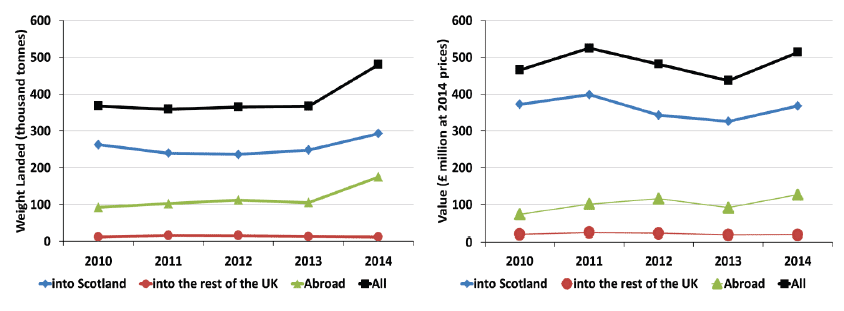
Landings by Scottish vessels accounted for 60 per cent of the value and 63 per cent of the quantity of all landings by UK vessels (Tables 1.1.e, 1.1.o and 1.1.v). Since 2013, these figures have increased by two and five percentage points respectively.
1.1.1 Demersal, pelagic and shellfish landings by Scottish based vessels
In 2014, 330 thousand tonnes of pelagic species were landed by Scottish vessels with a value of £220 million. This accounted for 69 per cent of all landings by Scottish vessels in terms of quantity and 43 per cent in terms of value. Demersal species represented 18 per cent of the quantity of all landings (89 thousand tonnes) and 28 per cent of the value (£143 million), while shellfish landings accounted for 13 per cent of landings by quantity (62 thousand tonnes) and 29 per cent by value (£151 million) (Chart 1.2).
Chart 1.2 Quantity and value of landings by Scottish vessels; percentage of each species type, 2014.
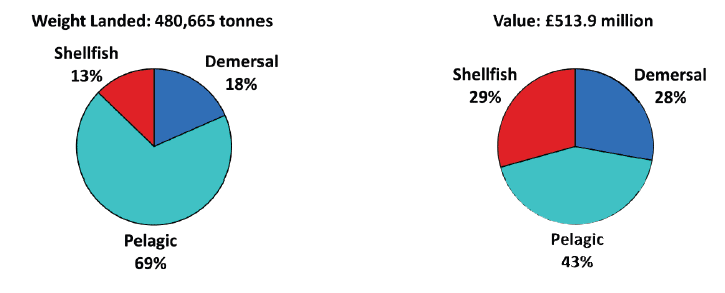
The 18 per cent increase in the value of landings by Scottish based vessels between 2013 and 2014 was driven predominantly by the increase in value of pelagic species, although the other two species types also had an increase in value (Chart 1.3). In real terms the value of pelagic landings increased by 42 per cent, shellfish landings value increased by eight per cent and demersal landings value increased by one per cent from 2013. In real terms the total increase in value from 2013 was £77 million.
The main factor for the rise in total value was the value of pelagic species increasing in real terms by 42 per cent (£64.5 million) since 2013, in particular the increase in value for mackerel. Mackerel is the most valuable species to the Scottish fishing industry, accounting for 38 per cent of the total value of Scottish landings in 2014 and 88 per cent of the value of pelagic landings. The value of mackerel in real terms rose 52 per cent from 2013, with the quantity landed increasing 79 per cent. Despite the value of mackerel rising, the average price of mackerel fell by 15 per cent, from £956 per tonne in 2013 to £813 per tonne in 2014. Herring, which represented four per cent of the total value of Scottish landings in 2014 and eight per cent of the total pelagic landings, decreased in value in real terms by 20 per cent, even though quantity landed increased by six per cent since 2013. The price per tonne of herring decreased by 24 per cent, from £399 per tonne to £301 per tonne.
In 2014, the value of shellfish species increased in real terms by eight per cent and is mainly due to the increase in value for Nephrops, which represents 15 per cent of the total value of Scottish landings in 2014 and 50 per cent of the value of shellfish landings. The value of Nephrops increased in real terms by 14 per cent (£9 million) from 2013. This is explained by the quantity landed increasing by 11 per cent and the price per tonne increasing by three per cent, from £3,551 per tonne to £3,656 per tonne.
The value of demersal species increased in real terms by one per cent (£1.5 million) since 2013. The value of monkfish, which represents five per cent of the total value of Scottish landings in 2014 and 17 per cent of the value of demersal landings, increased in real terms by 19 per cent, while the price per tonne decreased by five per cent, from £2,987 per tonne to £2,830 per tonne. The increase in value is due to the quantity landed increasing by 26 per cent. Haddock which represents eight per cent of the total value of Scottish landings in 2014 and 29 per cent of the value of demersal landings, increased in real terms by seven per cent (£2.7 million). The increase in value occurred despite a 12 per cent decrease in quantity landed. This is because the price per tonne increased by 22 per cent, from £1,136 per tonne to £1,381 per tonne.
Chart 1.3 Quantity and value of landings by Scottish vessels by each species type; 2010 to 2014.
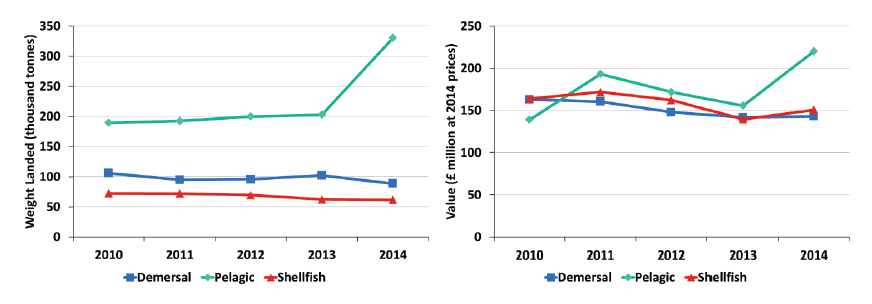
Chart 1.4 Percentage change from 2013 to 2014 in the real term price per tonne obtained for key fish species.
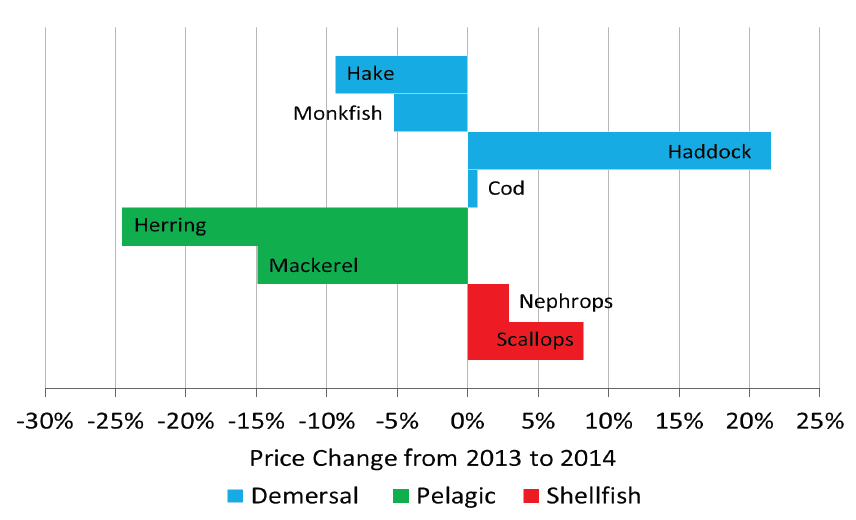
Prices of fish in 2013 and other years in real terms can be found in Table 1.1.x.
A breakdown of landings by Scottish vessels into Scotland, the rest of the UK, and abroad, by species are given in Tables 1.1.a to 1.1.e as well as corresponding figures for other UK vessels in Tables 1.1.f to 1.1.o, and figures for foreign vessels landings into the UK in Tables 1.1.p to 1.1.t.
Demersal fish
Demersal species contributed 28 per cent of the overall value of landings by Scottish vessels in 2014. The total quantity of demersal species landed by Scottish vessels decreased by 13 per cent from 2013, although the value increased in real terms by one per cent. Haddock, monkfish and cod are the three main demersal fish species landed by Scottish vessels in terms of value, accounting for 29 per cent, 17 per cent and 15 per cent respectively of all the demersal species landed in 2014. In terms of quantity landed by Scottish vessels, demersal species contributed 18 per cent of the overall quantity landed. Of all demersal species landed by Scottish vessels haddock accounts for 34 per cent, cod 12 per cent, monkfish and whiting both ten per cent and saithe nine per cent.
The value of demersal species increased by one per cent in real terms from 2013 despite the decrease of 13 per cent in the quantity landed. This was driven by increases in value of various species including monkfish, haddock and cod, which rose 19 per cent to £24.8 million, seven per cent to £42 million and two per cent to £22.1 million, respectively (Chart 1.5.a). The value of monkfish rose due to the 26 per cent increase in quantity landed even though the price per tonne decreased five per cent from £2,987 per tonne to £2,830 per tonne. Haddock increased in value in real terms even though there was a 12 per cent decrease in the quantity to 30.4 thousand tonnes. This increase in value is due to a 22 per cent increase in price per tonne from £1,136 per tonne to £1,381 per tonne. The increase in value in real terms for cod was due to a two per cent increase in price per tonne from £2,011 per tonne to £2,025 per tonne and a one per cent increase in the quantity of cod landed in 2014.
From the real term prices per tonne (Table 1.1.x and Chart 1.4), haddock, cod, megrim, saithe and whiting all showed an increase in price from 2013.
Chart 1.5.a Quantity and value of landings of key demersal species by Scottish vessels: 2010 to 2014.
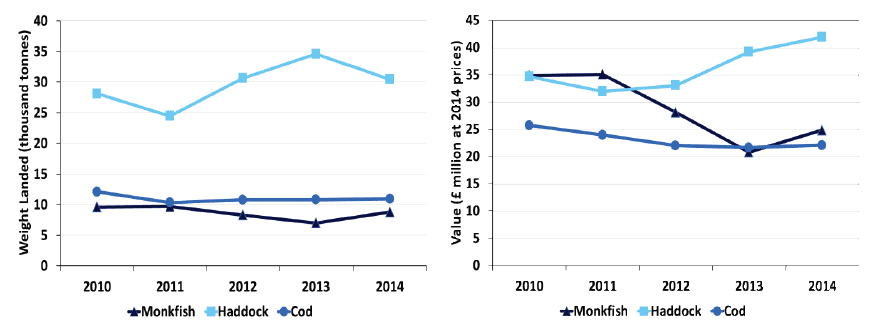
Pelagic fish
Mackerel and herring are the two main pelagic species landed by Scottish vessels both in terms of quantity and value. In 2014 the total quantity of pelagic species landed by Scottish vessels increased by 63 per cent from 2013 and the value increased in real terms by 42 per cent. Mackerel, the stock with the largest landings by the Scottish fishing fleet, accounted for 88 per cent of the value and 72 per cent of the quantity of all the pelagic landings by Scottish vessels. Herring accounted for eight per cent of the value and 19 per cent of the quantity, of all the pelagic landings by Scottish vessels in 2014.
From 2013 to 2014, the value of mackerel in real terms increased by 52 per cent and the quantity of landings increased by 79 per cent (Chart 1.5.b). However the price per tonne for mackerel underwent a 15 per cent decrease (Chart 1.4), down from £956 per tonne to £813 per tonne. The value in real terms of herring decreased by 20 per cent to £18.4 million, even though the quantity of landings increased six per cent to 61.4 thousand tonnes. This change in value was largely due to the 25 per cent decrease in price per tonne for herring, from £399 per tonne to £302 per tonne.
Blue whiting shows the largest increase in quantity landed and value in real terms between 2013 and 2014. The quantity landed rose 214 per cent to 25.6 thousand tonnes and the value in real terms rose 107 per cent to £3.8 million. This increase is due to the increase in UK quota for blue whiting in 2014.
Chart 1.5.b Quantity and value of landings of key pelagic species by Scottish vessels: 2010 to 2014.
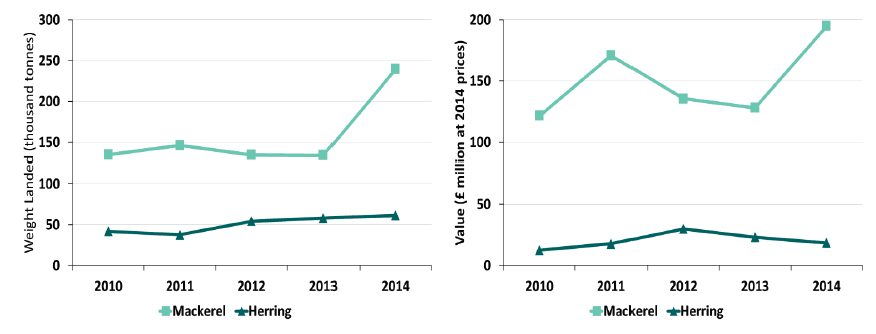
Shellfish
Nephrops and scallops are the two main species of shellfish landed by Scottish vessels. In 2014 the total quantity of shellfish species landed by Scottish vessels decreased by one per cent from 2013 and the value increased in real terms by eight per cent. Nephrops accounted for 50 per cent of the value and 33 per cent of the quantity of shellfish landed by Scottish vessels in 2014. Scallop landings accounted for 22 per cent of the value and 27 per cent of the quantity of all shellfish landings by Scottish vessels.
Nephrops are the most valuable shellfish species to the Scottish fishing industry, worth £74.8 million in 2014 and accounting for 15 per cent of the total value of all Scottish landings. The value of Nephrops landings by Scottish vessels increased by 14 per cent in real terms from 2013. This increase in value was driven by an 11 per cent increase in the quantity landed as well as a three per cent increase in the price per tonne, from £3,551 per tonne to £3,656 per tonne.
In 2014, the value of scallops in real terms increased one per cent from 2013 to £32.7 million and accounted for six per cent of the total value of all Scottish landings.
This increase in value occurred despite a seven per cent fall in the quantity of scallops landings. The decrease in quantity was offset by an eight per cent increase in the price per tonne, from £1,842 per tonne to £1,994 per tonne.
Edible crabs, lobsters and squid all had an increase in value in real terms and weight landed between 2013 and 2014. The weight landed of edible crabs increased 11 per cent from 2013 and the value increased by 14 per cent. Lobsters weight landed rose by 18 per cent while the value in real terms increased by 16 per cent. Squid experienced the largest increase in both quantity landed and value, with increases of 71 per cent and 34 per cent respectively. However the price per tonne of squid fell by 22 per cent in 2014, from £3,713 per tonne to £2,911 per tonne. Queen scallops saw a 32 per cent decrease in quantity landed, to 6.9 thousand tonnes, as well as a 37 per cent decrease in value in real terms to £3.2 million. The fall in quantity landed is due to poor queen scallops availability and the decrease in value is due to the lower quantity of queen scallops landed as well as the price per tonne decreasing by eight per cent, from £503 per tonne to £462 per tonne since 2013.
Chart 1.5.c Quantity and value of landings of key shellfish species by Scottish vessels: 2010 to 2014.
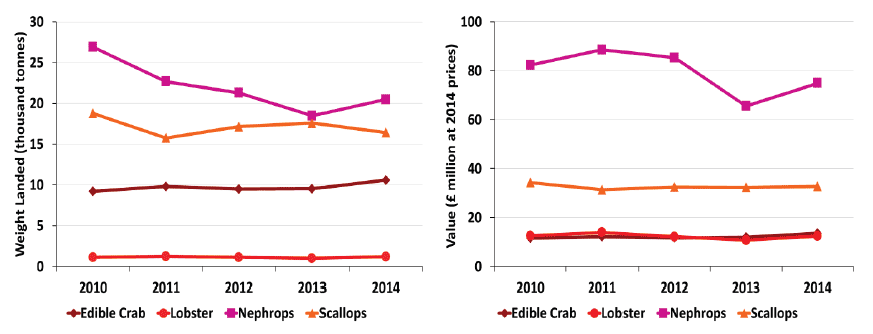
1.2 Landings abroad by Scottish based vessels
In 2014, Scottish vessels landed 175 thousand tonnes of sea fish and shellfish abroad with a corresponding value of £127 million. The quantity of landings abroad increased by 66 per cent and the value of landings abroad increased by 38 per cent in real terms since 2013. Landings abroad by Scottish vessels into Denmark, Germany, Ireland, Netherlands, Spain and Norway have increased both in quantity and value during 2014 (Table 1.1.d and 1.3).
Landings abroad accounted for 36 per cent of all landings by Scottish vessels in terms of quantity and 25 per cent in terms of value in 2014. Of this, 95 per cent of the quantity of landings abroad were pelagic, five per cent were demersal and less than half of one per cent were shellfish. The main species landed abroad in 2014 was mackerel, with a value of £95.8 million this represents 75 per cent of the total value of fish landed abroad in 2014. Since 2013, mackerel landings abroad have almost doubled in quantity (99 per cent) as well as seeing an increase in value in real terms by 57 per cent. There were 118.9 thousand tonnes of mackerel landed abroad, which is 50 per cent of the total quantity of mackerel landed by Scottish vessels. The price for mackerel landed into the UK in 2014 was, on average, £821 per tonne, while mackerel landed abroad received an average of £806 per tonne.
The majority of Scottish landings abroad were into Norway, and nearly all of these landings were pelagic species. In 2014, 91 per cent of the value of landings into Norway was for mackerel, amounting to 103.9 thousand tonnes with a value of £84 million. Only 0.5 thousand tonnes of shellfish were landed abroad by Scottish vessels in 2014, mainly into Ireland and Spain. The key countries for demersal landings were Netherlands and Spain. Scottish vessels landed eight thousand tonnes of demersal species abroad with a value of £14.9 million.
Figure 1.1.a Quantity of landings abroad by Scottish vessels by country of landing: 2014 (tonnes).
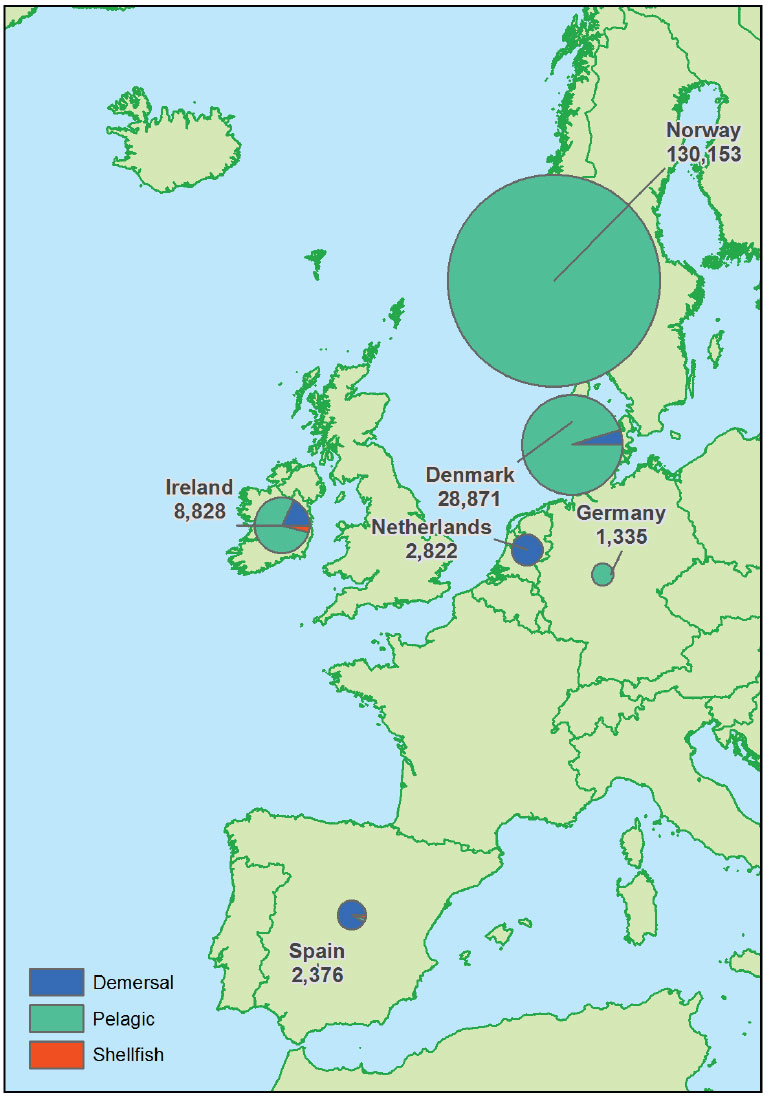
Figure 1.1.b Value of landings abroad by Scottish vessels by country of landing: 2014 (£' thousands).
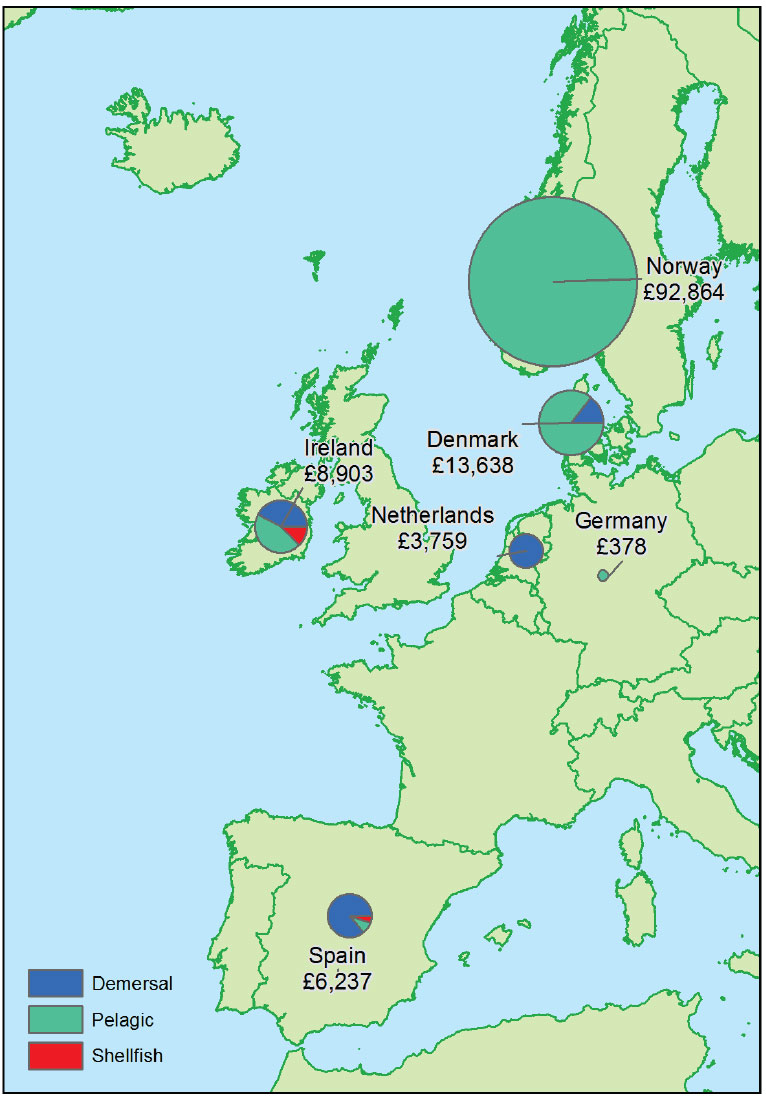
1.3 Landings by area of capture
The two main ICES areas that Scottish vessels were most active in during 2014 were the Northern North Sea ( ICES division IVa) and the West Coast of Scotland ( ICES division VIa) (Figures 1.2.a and 1.2.b). In the Northern North Sea (IVa), 243 thousand tonnes of sea fish and shellfish were caught with a value of £233 million, representing 51 per cent of the quantity and 45 per cent of the value of all landings by Scottish vessels (Table 1.6). Just under a third (30 per cent) of landings by Scottish vessels in terms of quantity were caught in the West Coast of Scotland (VIa), providing 35 per cent of the total value of all Scottish landings.
Seventy per cent of the quantity of all demersal landings by Scottish vessels were caught in the Northern North Sea (IVa). Of the total quantity of pelagic landings, 50 per cent were caught in the Northern North Sea (IVa) and 33 per cent were caught in the West Coast of Scotland (VIa). More shellfish species were caught in the West Coast than in the Northern North Sea. In terms of quantity shellfish catches from the West of Scotland accounted for 38 per cent of all shellfish landings, whereas 25 per cent of shellfish landings were caught in the Northern North Sea. The Central North Sea ( ICES division IVb) and the Irish Sea (VIIa) are also areas of considerable activity for shellfish fisheries. Fourteen per cent of shellfish catches are from the Central North Sea and 15 per cent are from the Irish Sea, where almost all catches from the Irish Sea are of shellfish species. The rest of Area VII (i.e. not the Irish Sea) had considerable activity from demersal, pelagic and shellfish vessels, with five per cent of the quantity of all landings being caught in this area.
Further maps of fishing activity in the seas around the UK by Scottish vessels, other UK vessels, and foreign vessels that land into the UK will be available on the ICES rectangle webpage on the Scottish Sea Fisheries Statistics website. These maps show the quantity and value of landings by species type by ICES rectangle.
Figure 1.2.a Quantity of landings by Scottish vessels by area of capture: 2014 (tonnes).
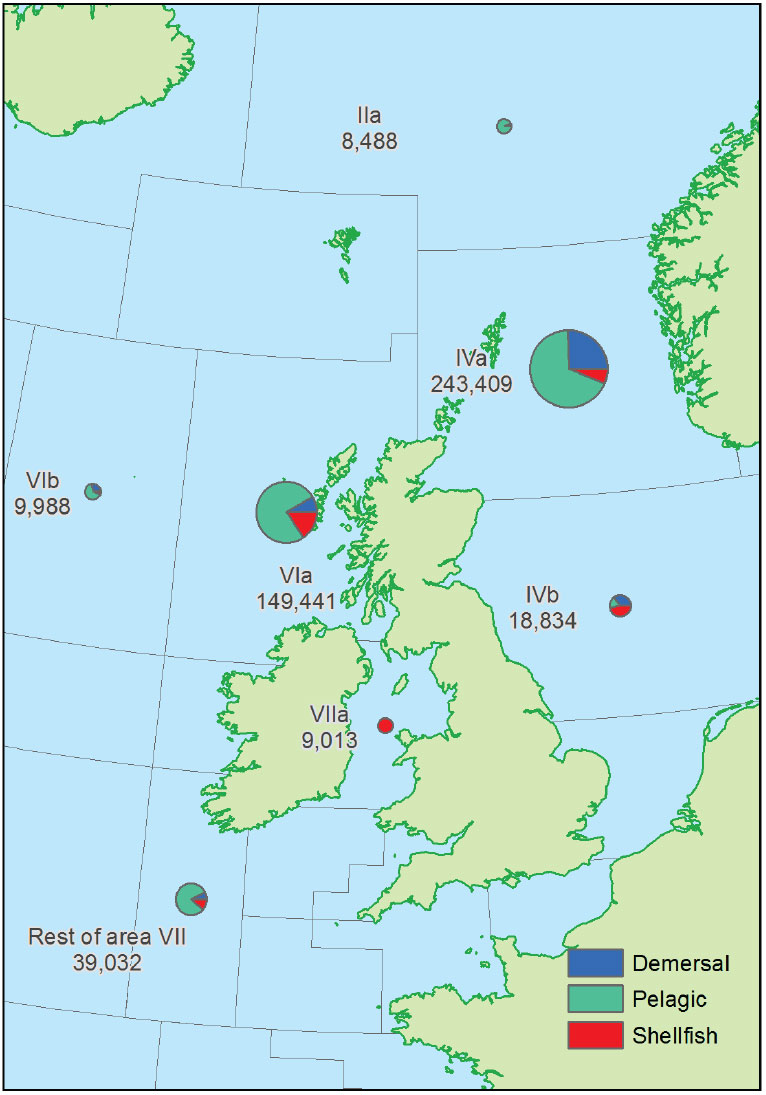
Figure 1.2.b Value of landings by Scottish vessels by area of capture: 2014 (£'thousand).
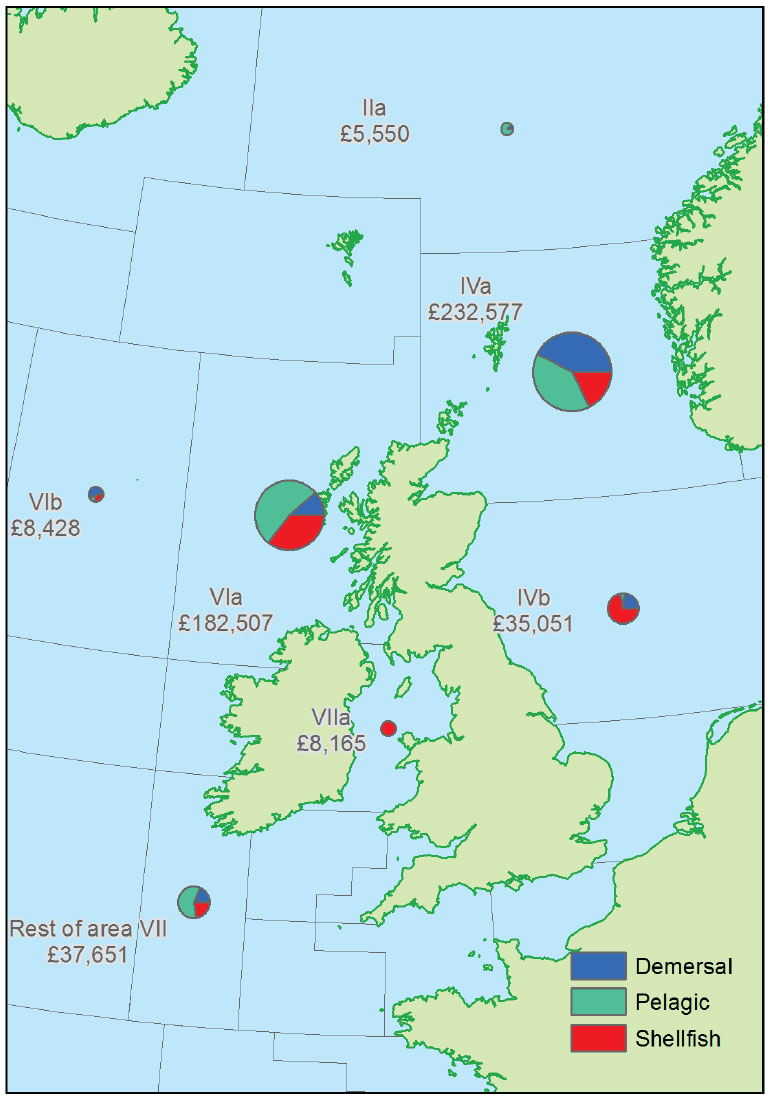
1.4 Landings into Scotland
In 2014, there were 375 thousand tonnes of sea fish and shellfish landed into Scotland with a value of £469 million. This represents a 20 per cent increase in quantity and a 17 per cent increase in value since 2013. Landings of demersal species accounted for 42 per cent, shellfish species 30 per cent and pelagic species 28 per cent of the total value of all landings into Scotland. However, in terms of quantity, 54 per cent of landings into Scotland were pelagic, 32 per cent were demersal and 14 per cent were shellfish species. The differences in how each species type contributed to the total value and total quantity of landings into Scotland highlight the differences between the prices per tonne across the species types. Shellfish receive relatively high prices per tonne, whilst pelagic species receive lower prices per tonne (Table 1.1.s).
Figure 1.3.a and b and Table 1.7 show landings by all vessels by species type into the eighteen Scottish districts. Landings into the south-west coast and south-east coast were dominated by shellfish, while landings into the north-west coast constituted both demersal and, to a lesser extent, shellfish species. The three largest districts in Scotland in terms of landings were Peterhead (east coast), Shetland (north) and Fraserburgh (east coast). These districts receive landings of all three species types, although Peterhead and Shetland receive relatively small amounts of shellfish compared to demersal and pelagic species.
Combined, the top three districts accounted for 76 per cent in quantity and 59 per cent in value of all landings into Scotland. Peterhead saw 184 thousand tonnes landed in 2014, with a value of £164 million. In terms of quantity, 69 per cent of the landings were pelagic species which accounted for 46 per cent of the landings value into Peterhead. In contrast, 29 per cent of the quantity of the landings were demersal species which accounted for 48 per cent of the value into Peterhead. Landings into Shetland totalled 77 thousand tonnes at a value of £75 million. As with Peterhead, the majority of landings into Shetland were pelagic species, which represented 76 per cent of the total quantity and 58 per cent of the total value of landings into Shetland. Demersal species accounted for 21 per cent of the quantity and 36 per cent of the value landed into Shetland. In contrast, the third biggest district, Fraserburgh, had a higher proportion of shellfish landings, representing just over half the value of the landings (51 per cent). In terms of quantity, 52 per cent of landings into Fraserburgh were pelagic species and 25 per cent were shellfish species.
Figure 1.3.a Quantity of landings into Scotland by all vessels by district: 2014 (tonnes).
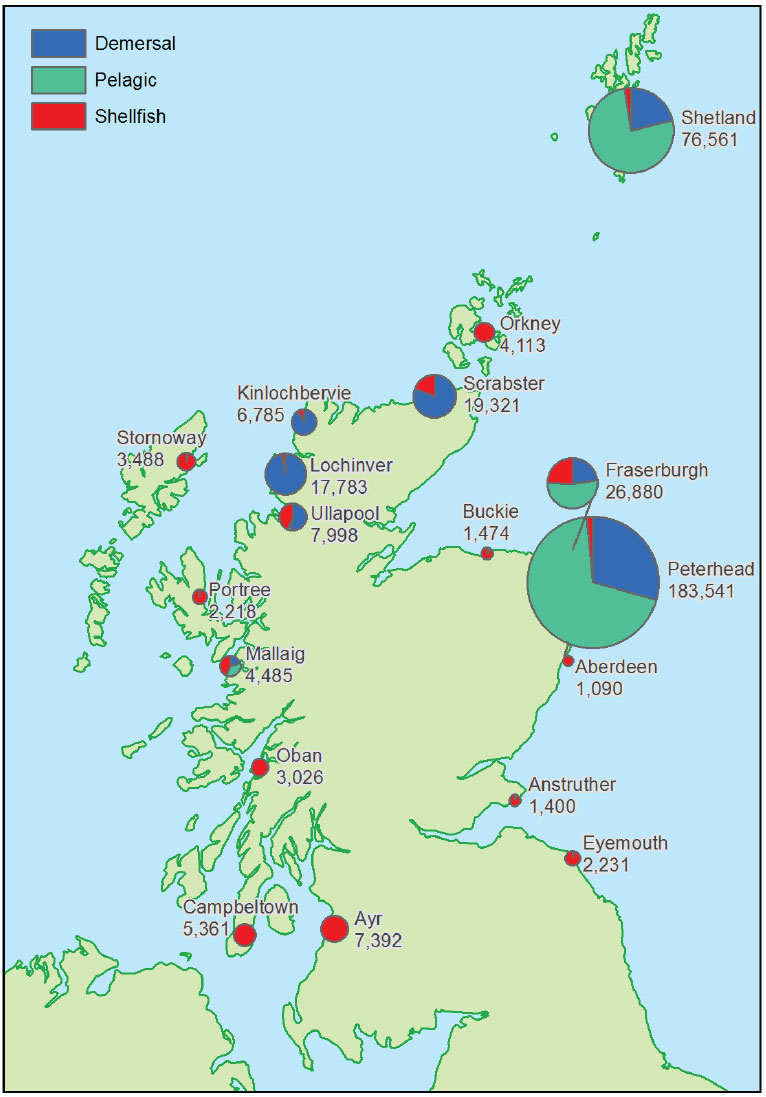
Figure 1.3.b Value of landings into Scotland by all vessels by district: 2014 (£'thousand).
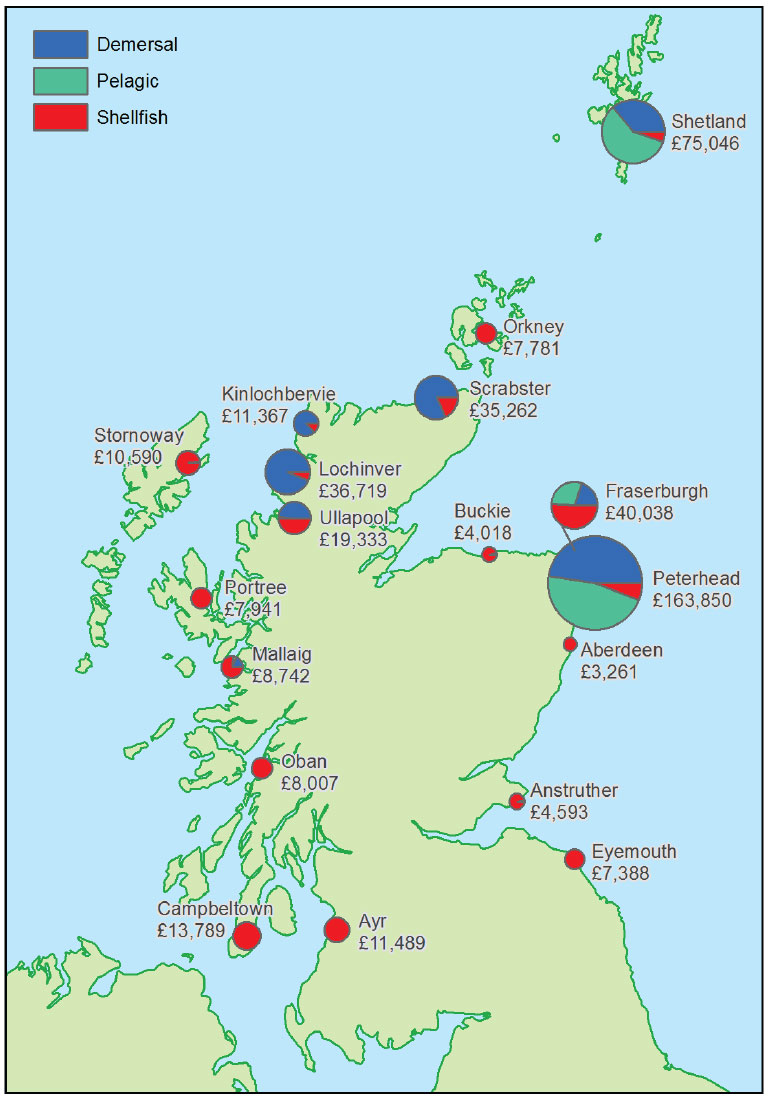
1.5 Total allowable catches: quota and uptake
Table 1.10 shows the total allowable catch ( TAC) for stocks. TACs are a catch limit set for individual stocks and are fixed on an annual basis at international negotiations. Some stocks are managed and fished only by European Union ( EU) member states and the TAC for these are set by the European Commission through internal negotiations between those EU member states with an interest. Other stocks are managed and shared with non- EU states and TACs for these are set at separate negotiations with interested parties, particularly Norway, Iceland, the Faroe Islands and the Russian Federation (the 'Coastal States').
The EU TAC is shared among EU member states based on a number of factors, including each member state's past catch record. This share, known as quota, is displayed in Table 1.10 at the UK and at the Scottish Producers Organisations ( POs) level. The quantity and percentage uptake of this quota is also given for each stock in Table 1.10.
Chart 1.6 compares the quota uptake of important demersal and pelagic stocks in Scottish Producer Organisations in 2014 and 2013. Both North Sea haddock and West of Scotland haddock exceeded 100 per cent quota uptake. North Sea cod exceeded 99 per cent quota uptake, while North Sea monkfish was just under 99 per cent. North Sea saithe reached 97 per cent and North Sea Whiting reached 94 per cent. At the end of 2014, North Sea Nephrops quota uptake was 78 per cent, 30 percentage points higher than 2013. This is due to a lower quota being set in 2014 as well as an increase in quantity landed. In the West of Scotland, monkfish quota uptake exceeded 99 per cent, while saithe and Nephrops quota uptake reached 86 per cent and 81 per cent respectively. Quota uptake exceeded 100 per cent for North Sea herring and West of Scotland mackerel. The West of Scotland herring quota uptake was 99 per cent in 2014.
Chart 1.6 Quota uptakes of important stocks by vessels in Scottish POs in 2014 and 2013.
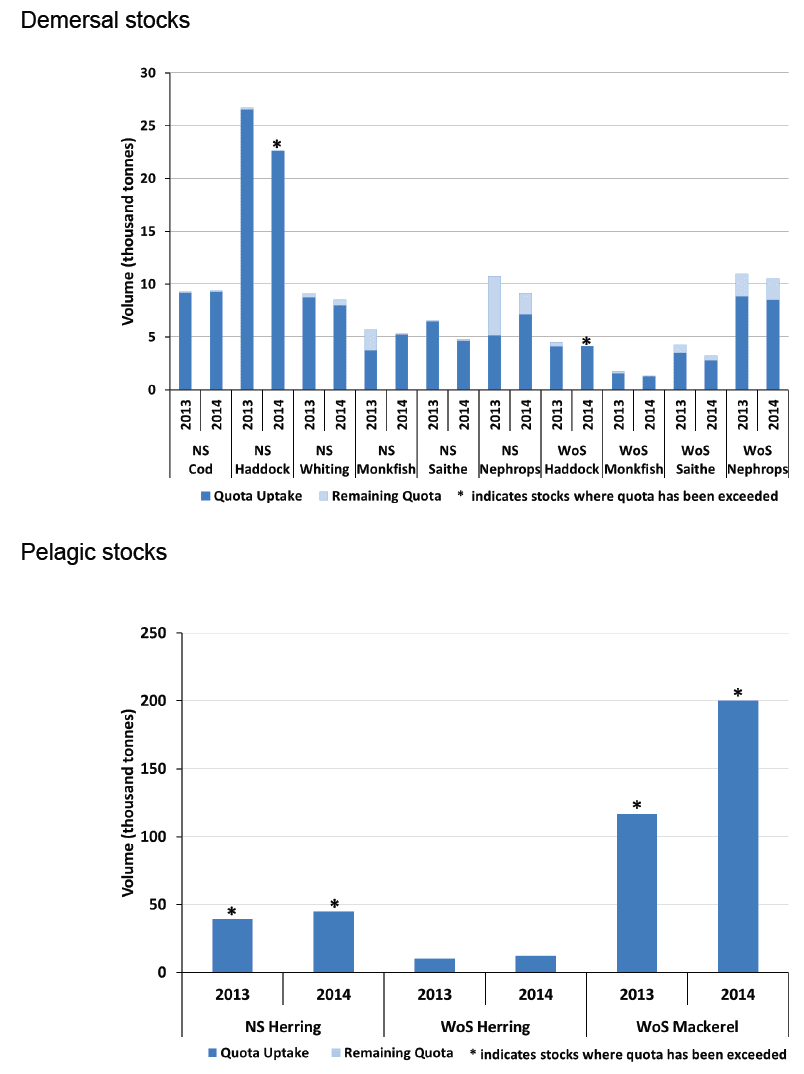
Contact
There is a problem
Thanks for your feedback